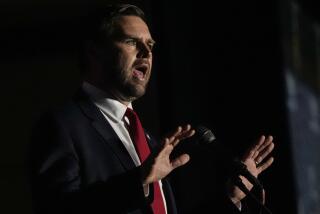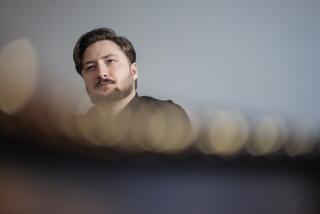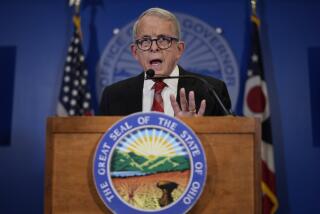Paying homage to a land of presidents
I had no intention of lingering in Ohio last August when I drove through heading west from Philadelphia. My itinerary for the Buckeye State included pumping gas, grabbing burgers and finding restrooms. But a sign on Interstate 80 near Fremont sparked my curiosity: “Rutherford B. Hayes Presidential Center.”
What did I really know about President Hayes? On an impulse, I took the exit.
What I found was a charming, tree-shaded Victorian estate full of fascinating glimpses into the past. The Spiegel Grove home of the 19th president (1877-81) sits on 25 acres and includes a museum, Hayes’ burial plot and the family home — a grand mansion with 15 fireplaces, a center hallway 45 feet high and a butternut staircase supported by 177 hand-carved spindles.
I learned a lot about the president. The museum displayed a jacket worn by Brig. Gen. Hayes in the Civil War. A hole in the left sleeve near the bicep showed where a Rebel bullet struck him. He was injured five times in the war. In 1876, Hayes slipped into office by one electoral vote after losing the popular vote in a bitterly disputed election.
As I left Spiegel Grove, I reflected on something the tour guide said: “Eight presidents came from Ohio.” I wanted to know more. Who were these presidents and what was their legacy? Later, at home, I researched the subject. In October, I returned to Ohio for a week to learn their stories.
My first stop: Niles, Ohio. Our 25th president, William McKinley (1897-1901), was born here in 1843, half a block from the National McKinley Birthplace Memorial. The structure, consisting of a library and museum, is fronted by a Court of Honor made up of the busts of statesmen and an imposing statue of the president.
Inside, a reference librarian invited me on a self-guided tour. A video traced McKinley’s life from his birth as the seventh child in a family of nine kids to his assassination. In between, there were highs and lows, with tragedy striking frequently. The first heartbreak came in 1873 after his marriage to Ida Saxton, when the couple lost their youngest daughter, who died at 4 months. It was followed by the death of Ida’s mother, and then the death of their 3-year-old, Katherine. Then Ida became a semi-invalid. McKinley embarked on his political career at this time.
Museum artifacts included a $500 bill with McKinley’s portrait, the original draft of his 1896 presidential nomination speech and a Sept. 7, 1901, copy of the Boston Evening Transcript published the day after he was shot in Buffalo, N.Y.: “Chances good. Second Bullet May be Located by X-rays.” McKinley died one week later.
My next stop took me two hours northwest to the James A. Garfield National Historic Site in Mentor, Ohio. Garfield (1881) was the 20th president and the last born in a log cabin. Success in the Civil War earned him the stars of a brigadier general. When President Lincoln asked him to fight the war on a political front instead of the battlefield, Garfield ran for office, becoming a congressman in 1862. Friends admired his jovial temperament, citing the time Garfield laughed so hard at a joke he fell to the ground and rolled over.
An assassin’s bullet shattered his promising career less than four months after his inauguration. In the 79 days after the shooting, the president was in constant pain and lost 65 pounds. He died of blood poisoning in 1881, an infection many attribute to the probing of numerous doctors as they tried to retrieve the bullet.
Reporters who gathered for Garfield’s “front porch” speeches nicknamed the Victorian home “Lawnfield.” I walked around inside, listening as a tour guide talked about the life of the president, hearing about such tidbits as the hole in the ceiling through which Molly, the president’s daughter, once poured water onto her sleeping brothers. On a bedroom wall hung a photograph of Molly with her back to the camera. Garfield’s notation on the back of the picture read, “Molly in a huff.”
After spending a night in Columbus, Ohio, I followed Interstate 70 west 150 miles to Indianapolis. Benjamin Harrison (1889-1893), our 23rd president, was born in North Bend, Ohio, later moving to the Hoosier State capital to practice law.
The President Benjamin Harrison Home, in the city’s historic Old North Side, was built in the Italianate style with ceilings 14 feet high.
Like Hayes, Harrison lost the popular vote in his presidential race but squeaked to victory in 1888 on the strength of a majority in the electoral college. Benjamin, the grandson of President William Harrison, was a Presbyterian elder and wartime general. More than 250,000 people journeyed to his home in 1888 for the candidate’s campaign speeches. Harrison accepted his party’s nomination in the parlor; he received news he was elected in the family library. In 1901, he died there in bed.
All in the family
Returning to Ohio, I found North Bend in the southwest corner of the state, birthplace of Benjamin Harrison and the burial ground of his grandfather, William Henry Harrison, ninth president of the United States. William’s son, John Scott Harrison, is the only man who was the father and the son of a U.S. president.William, born in Virginia, enrolled at the University of Pennsylvania’s medical school but dropped out to fight in the Indian wars on the western frontier. Eventually, he took command of Ft. Washington in what is now Cincinnati. His greatest wartime achievement was his victory at the Battle of Tippecanoe near Lafayette, Ind., in 1811, which earned him the title “Old Tip” and catapulted him to the rank of major general.
In 1840 the Whig candidate was swept into office with the slogan “Tippecanoe and Tyler too.” (John Tyler was his running mate.) But at age 67, Harrison caught a severe cold while delivering a lengthy inaugural speech in foul weather. He died 31 days later.
I strolled the grounds of the Harrison Tomb State Memorial overlooking the Ohio River. I walked onto a flagstone patio and sat on a limestone bench. Beyond the hum of the highway, I could see the river curling around Kentucky’s northern border. It was a beautiful location. I could understand why Harrison asked to be buried here.
My next stop was Cincinnati, where I visited the William Howard Taft National Historic Site, operated by the National Park Service. The site offers a museum as well as the 27th president’s birthplace and childhood home. A Yale graduate, Taft (1909-13) became a lawyer and a Superior Court judge. In 1904, Teddy Roosevelt appointed him Secretary of War.
Bob Taft, Ohio’s current governor, is William’s great-grandson.
Elected to the Oval Office in 1908, William declared it “the loneliest job in the world” and began gaining weight, eventually tipping the scale at 335 pounds. After his presidency, William G. Harding selected him as chief justice of the Supreme Court, a post Taft loved. “Presidents come and go,” he said, “but the court goes on forever.” Park ranger Kerry Wood, a Taft scholar, guided me on a tour of the home.
With only two stops left on my agenda, I drove to Point Pleasant, southeast of Cincinnati. Near the confluence of Indian Creek and the Ohio River stood a cabin — 16 1/2 by 19 feet — where Civil War hero Ulysses S. Grant was born in 1822. I entered the building and was greeted by Loretta Furman, its curator of 37 years.
Loretta proudly showed me family heirlooms: an original pillowcase, the traveling chest that Grant (1869-77) took to West Point, a pair of boots made by Grant’s father in 1826.
“Look at this,” she said, pointing to a marker above the front door. “In 1937, a flood on the Ohio River staged at 80 feet.” Quick action by the neighbors saved the Grants’ artifacts.
A handshake and $10 secured a campsite for the night at the Riverside Campground on the banks of the Ohio. In the morning I traveled north and stopped for gas in Delaware, Ohio. Dozens of gas stations are operated in this bustling community, but I looked for the BP station on East William Street. Adjacent to the pumps stood a monument behind a phone booth flanked by bushes. Etchings on the slab indicated that Rutherford B. Hayes was born here in 1822. I filled my tank and headed inside.
“People stop here to see the president’s birthplace?” I asked the clerk. He studied me from behind the counter. “Nope. They just want gas.”
“What happened to Hayes’ house?” I asked. He shrugged.
My final stop was Marion, Ohio, home to Warren G. Harding, 29th president (1921-23) and the only man elected to the Oval Office on his birthday. Harding was the oldest of eight children. In the election year of 1920, 600,000 pilgrims trekked here from the local train station to hear Harding’s campaign speeches.
Our tour guide, Shannon Morris, asked that we touch nothing in the house, explaining that 90% of the objects belonged to the Hardings, the highest percentage of original materials found in any presidential home.
The president’s straw hat collection sat on a closet shelf. Upstairs, we saw a cricket cage that his wife, Florence, kept in her bedroom because the insects were thought to bring good luck. She probably needed it. Harding was no model of fidelity. Love letters in the president’s handwriting revealed that he indulged in extramarital affairs. Allegations of an illegitimate child also clouded his reputation. When Bill Clinton’s sex scandals became public, “reporters rang our phone off the hook” seeking information about Harding’s dalliances, Morris said.
Additionally, corruption festered during his presidency. Some of his appointees stole public funds. But our guide maintained that history exaggerated Harding’s faults. Despite the man’s personal weaknesses, his greatest mistake may have been the trust he placed in unworthy associates, Morris said.
It was an interesting comment. Like many things I’d seen in the last week, it made me think. And it helped me understand Ohio’s thriving legacy: the preservation of history.
Buckeye State bound
GETTING THERE:
From LAX to Columbus, Southwest offers direct service (stop, no change of planes); US Airways, United, Northwest, American, Continental, America West, Delta and Midwest Express have connecting flights (change of planes). Restricted round-trip fares begin at $198.
To Indianapolis, Southwest offers nonstop service; United flies direct; Northwest, US Airways, Continental, Delta, American, Midwest Express and Frontier airlines have connecting service. Restricted round-trip fares begin at $178.
PRESIDENTIAL SITES:
Rutherford B. Hayes Presidential Center, Spiegel Grove, Fremont, OH 43420; (800) 998-7737, https://www.rbhayes.org . Includes museum, family home and library.
National McKinley Birthplace Memorial, 40 N. Main St., Niles, OH 44440; (330) 652-1704, https://www.mckinley.lib.oh.us . After touring the museum, visit a replica of McKinley’s birthplace down the street.
James A. Garfield National Historic Site, 8095 Mentor Ave., Mentor, OH 44060; (440) 255-8722, https://www.nps.gov/jaga . Take a 35-minute tour of the president’s restored home and watch an 18-minute video about his life.
President Benjamin Harrison Home, 1230 N. Delaware St., Indianapolis, IN 46202; (317) 631-1888, https://www.presidentbenjaminharrison.org . There are a museum, library and exhibits; the carriage house has information on the women’s suffrage movement.
William Howard Taft National Historic Site, 2038 Auburn Ave., Cincinnati, OH 45230; (513) 684-3262, https://www.nps.gov/wiho . Tour Taft’s restored birthplace and four period rooms that reflect the family life during his boyhood.
Harrison Tomb State Memorial, The limestone sepulcher is on the summit of Mt. Nebo near Cincinnati. Nearby is Congress Green Cemetery, set aside as a burial ground for Harrison’s extended family. For information, contact the Ohio Historical Society, 1982 Velma Ave., Columbus, OH 43211; (800) 686-1535, culture.ohio.gov/project.asp?proj=Harrison.
Grant Birthplace, U.S. Routes 52 and 232, Point Pleasant, Ohio 45153; (513) 553-4911, https://www.ohiohistory.org/places/grantbir . It houses a small museum and gift shop. Open April through October.
Warren G. Harding Home, 380 Mount Vernon Ave., Marion, OH 43302; (800) 600-6894. The site is open by appointment only until Memorial Day. Harding’s ornate tomb, a short distance across town, is also worth visiting.
WHERE TO STAY:
Comfort Inn, 7701 Reynolds Road, Mentor, OH 44060; (440) 951-7333, https://www.choicehotels.com . Enjoy the indoor pool, Jacuzzi and workout area. Doubles begin at $59.
Indianapolis Courtyard Downtown, 501 W. Washington St., Indianapolis, IN 46204; (317) 635-4443, https://www.marriott.com . Eight-story hotel downtown has a TGI Friday’s. Doubles from $139.
Best Western Mariemont Inn, 6880 Wooster Pike, Cincinnati, OH 45227; (877) 271-2111, https://www.bestwestern.com . Tudor exterior; free newspaper. Doubles start at $88.
WHERE TO EAT:
Sawyer House, 9470 Mentor Ave., Mentor OH, 44060, (440) 358-0100, https://www.sawyerhouserestaurant.com . Built in 1843, American cuisine with a European influence. Entrees start $15.95.
Steve’s Dakota Grill, 1950 Marion-Mt. Gilead Road, Marion, OH 43302; (740) 725-9033, https://www.stevesdakotagrill.com . A lively atmosphere at this popular eatery. Steaks and seafood. Entrees start $9.99.
Our Place, 701 Columbia St. (U.S. Route 52), Higginsport, OH, 45131; (937) 375-6771. Comfort food. Great pumpkin pie. Entrees start at $5.95.
TO LEARN MORE:
Ohio Division of Travel and Tourism, P.O. Box 1001, Columbus, OH 43216; (800) 282-5393, https://www.ohiotourism.com .
More to Read
Sign up for The Wild
We’ll help you find the best places to hike, bike and run, as well as the perfect silent spots for meditation and yoga.
You may occasionally receive promotional content from the Los Angeles Times.






